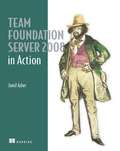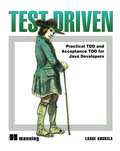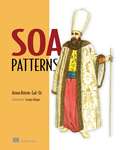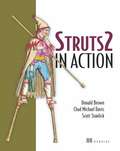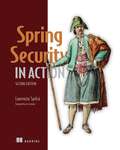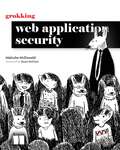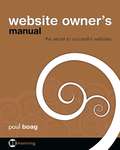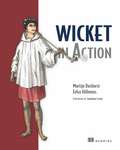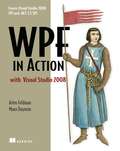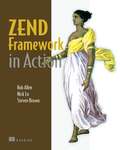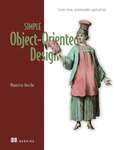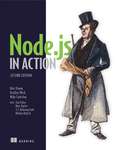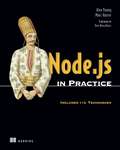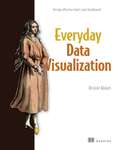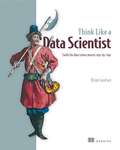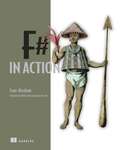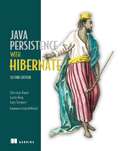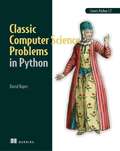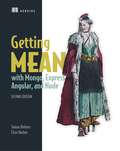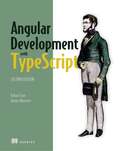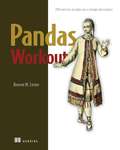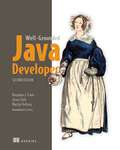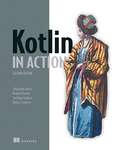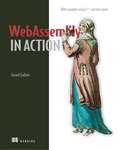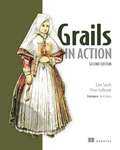- Table View
- List View
Team Foundation Server 2008 in Action
by Jamil AzherIn complex software projects, managing the development process can be as critical to success as writing the code itself. A project may involve dozens of developers, managers, architects, testers, and customers, hundreds of builds, and thousands of opportunities to get off-track. To keep tabs on the people, tasks, and components of a medium- to large-scale project, most teams use a development system that allows for easy monitoring, follow-up, and accountability.Microsoft Team Foundation Server 2008 (TFS), the server component of Microsoft's Visual Studio Team System (VSTS), provides a powerful collaborative platform for software-development teams. The product offers an integrated toolset for tracking work items, creating test cases, managing source code, generating builds, constructing database schemas, and so on. Because in software development one size does not fit all, TFS provides process customization, project management, and reporting capabilities to build solutions around your requirements.Team Foundation Server 2008 in Action is a hands-on guide to Team Foundation Server 2008. Written for developers with a good handle on TFS basics, this book shows you how to solve real-life problems. It's not a repetition of Microsoft's product documentation. Team Foundation Server 2008 in Action is a practitioner's handbook for how to work with TFS under common constraints. This book walks you through real-life software engineering problems based on hundreds of hours of TFS experience.You'll benefit from expert author Jamil Azher's extensive interactions with members of Microsoft's TFS team and MVPs, survey feedback from the author's blog, and interviews with organizations and user groups using TFS. Instead of just offering a high-level overview, the book provides detailed solutions for solving common-and not-so-common-problems using TFS. It discusses the strengths as well as weaknesses of TFS, and suggests appropriate problem resolution steps, workarounds, or custom solutions. Purchase of the print book comes with an offer of a free PDF, ePub, and Kindle eBook from Manning. Also available is all code from the book.
Test Driven: Practical TDD and Acceptance TDD for Java Developers
by Lasse KoskelaIn test driven development, you first write an executable test ofwhat your application code must do. Only then do you write thecode itself and, with the test spurring you on, you improve yourdesign. In acceptance test driven development (ATDD), you usethe same technique to implement product features, benefiting fromiterative development, rapid feedback cycles, and better-definedrequirements. TDD and its supporting tools and techniques leadto better software faster.Test Driven brings under one cover practical TDD techniquesdistilled from several years of community experience. With examplesin Java and the Java EE environment, it explores both the techniquesand the mindset of TDD and ATDD. It uses carefully chosen examplesto illustrate TDD tools and design patterns, not in the abstractbut concretely in the context of the technologies you face at work.It is accessible to TDD beginners, and it offers effective and less wellknown techniques to older TDD hands. Purchase of the print book comes with an offer of a free PDF, ePub, and Kindle eBook from Manning. Also available is all code from the book. What's InsideLearn hands-on to test drive Java codeHow to avoid common TDD adoption pitfallsAcceptance test driven development and the Fit frameworkHow to test Java EE components-Servlets, JSPs, and SpringControllersTough issues like multithreaded programs and data access code
SOA Patterns
by Arnon Rotem-Gal-OzSummarySOA Patterns provides architectural guidance through patterns and antipatterns. It shows you how to build real SOA services that feature flexibility, availability, and scalability. Through an extensive set of patterns, this book identifies the major SOA pressure points and provides reusable techniques to address them. Each pattern pairs the classic problem/solution format with a unique technology map, showing where specific solutions fit into the general pattern.About the TechnologyThe idea of service-oriented architecture is an easy one to grasp and yet developers and enterprise architects often struggle with implementation issues. Here are some of them:How to get high availability and high performanceHow to know a service has failedHow to create reports when data is scattered within multiple servicesHow to make loose coupling looserHow to solve authentication and authorization for service consumersHow to integrate SOA and the UIAbout the BookSOA Patterns provides detailed, technology-neutral solutions to these challenges, and many others, using plain language. You'll understand the design patterns that promote and enforce flexibility, availability, and scalability. Each of the 26 patterns uses the classic problem/solution format and a unique technology map to show where specific solutions fit into the general pattern.The book is written for working developers and architects building services and service-oriented solutions. Knowledge of Java or C# is helpful but not required.Purchase of the print book comes with an offer of a free PDF, ePub, and Kindle eBook from Manning. Also available is all code from the book.Table of ContentsPART 1 SOA PATTERNSSolving SOA pains with patternsFoundation structural patternsPatterns for performance, scalability, and availabilitySecurity and manageability patternsMessage exchange patternsService consumer patternsService integration patternsPART 2 SOA IN THE REAL WORLDService antipatternsPutting it all together—a case studySOA vs. the world
Struts 2 in Action
by Andrew Psaltis Chad Michael DavisThe original Struts project revolutionized Java web development and its rapid adoption resulted in the thousands of Struts-based applications deployed worldwide. Keeping pace with new ideas and trends, Apache Struts 2 has emerged as the product of a merger between the Apache Struts and OpenSymphony WebWork projects, united in their goal to develop an easy-to-use yet feature-rich framework. Struts 2 represents a revolution in design and ease of use when compared to classic Struts. It adds exciting and powerful features such as a plugin framework, JavaServer Faces integration, and XML-free configuration.Struts 2 In Action introduces the Apache Struts 2 web application framework and shows you how to quickly develop professional, production-ready modern web applications. Written by Don Brown, one of the leading developers of Struts 2, Chad Davis, a passionate Struts 2 developer, along with Scott Stanlick, this book gently walks you through the key features of Struts 2 in example-driven, easy-to-digest sections.Struts 2 in Action delivers accurate, seasoned information that can immediately be put to work. This book is designed for working Java web developers-especially those with some background in Struts 1 or WebWork. The core content, covering key framework components such as Actions, Results, and Interceptors, includes new features like the annotation-based configuration options. You'll find chapters on Struts 2 plugins, FreeMarker, and migration from Struts 1 and WebWork 2. Finally, new topics such as the Ajax tags, Spring Framework integration, and configuration by convention give familiar subjects new depth. Purchase of the print book comes with an offer of a free PDF, ePub, and Kindle eBook from Manning. Also available is all code from the book.
Spring Security in Action, Second Edition (In Action)
by Laurentiu SpilcaDon't let security be an afterthought. Spring Security in Action, Second Edition is your vital companion to robust, secure applications that are protected right from the first line of code.Spring Security in Action, Second Edition is a revised version of the bestselling original, fully updated for Spring Boot 3 and Oauth2/OpenID Connect. In Spring Security in Action, Second Edition you will learn essential security skills including how to: Implement and customize authentication and authorization Set up all components of an OAuth2/OpenID Connect system Utilize CRSF and CORS configurations Secure Spring reactive applications Write tests for security configurations Whether you&’re a beginner or a pro, Spring Security in Action, Second Edition teaches you how to secure your Java applications from the ground up. Author Laurentiu Spilca distills his years of experience as a skilled Java and Spring developer into an indispensable guide to everything security—from authentication and authorization, to testing security configurations. This new edition covers the latest patterns for application-level security in Spring apps, demonstrating how Spring Security simplifies every step of the security process. Foreword by Joe Grandja. About the technology Spring Security makes it much, much easier to secure enterprise-scale Java applications. This powerful framework integrates with Spring apps end to end, with &“secure by design&” principles and ready-to-use features that help you implement robust authorization and authentication and protect against data theft and intrusions. And like everything else in the Spring ecosystem, it&’s free, open source, and backed by the awesome team at VMWare. About the book Spring Security in Action, Second Edition updates this bestselling guide to Spring Security to include deep coverage of OAuth2/OpenID Connect and security configuration using the new SecurityFilterChain. The crystal clear explanations and relevant examples, teach you how to build your own authorization server, configure secure endpoints, and prevent cross-site scripting and request forgery attacks. What's inside Custom authentication and authorization CRSF and CORS configurations Secure Spring reactive applications Write tests for security configurations About the reader For experienced Java and Spring developers. About the author Laurentiu Spilca is a skilled Java and Spring developer and an experienced technology instructor. He is also the author of Manning&’s Spring Start Here and Troubleshooting Java. Table of Contents PART 1 1 Security today 2 Hello, Spring Security PART 2 3 Managing users 4 Managing passwords 5 A web app&’s security begins with filters 6 Implementing authentications PART 3 7 Configuring endpoint-level authorization: Restricting access 8 Configuring endpoint-level authorization: Applying restrictions 9 Configuring CSRF protection 10 Configuring CORS 11 Implementing authorization at the method level 12 Implementing filtering at the method level PART 4 13 What are OAuth 2 and OpenID Connect? 14 Implementing an OAuth 2 authorization server 15 Implementing an OAuth 2 resource server 16 Implementing an OAuth 2 client PART 5 17 Implementing security in reactive applications PART 6 18 Testing security configurations
Grokking Web Application Security
by Malcolm McDonaldWhen you launch an application on the web, every hacker in the world has access to it. Are you sure your web apps can stand up to the most sophisticated attacks?Trying to teach yourself about web security from the internet can feel like walking into a huge disorganized library—one where you can never find what you need, and the wrong advice might endanger your application! You need a single, all-in-one guide to securing your apps against all the attacks they can and will face. You need Grokking Web Application Security. This brilliantly illustrated and clearly written guide delivers detailed coverage on: Browser security, including sandboxing, the same-origin policy, and cookie security Securing web servers with input validation, escaping of output, and defense in depth A development process that prevents security bugs Browser vulnerabilities, from cross-site scripting and cross-site request forgery, to clickjacking Network vulnerabilities, such as man-in-the-middle attacks, SSL-stripping, and DNS poisoning Authentication vulnerabilities, such as brute forcing of credentials with single sign-on or multi-factor authentication Authorization vulnerabilities, such as broken access control and session jacking How to use encryption in web applications Injection attacks, command execution attacks, and remote code execution attacks Malicious payloads that can be used to attack XML parsers and file upload functions Grokking Web Application Security teaches you how to build web apps that are ready and resilient to any attack. It&’s laser-focused on what the working programmer needs to know about web security. In it, you&’ll find practical recommendations for both common and not-so-common vulnerabilities—everything from SQL injection to cross-site scripting inclusion attacks. You&’ll learn what motivates hackers, discover the latest tools for identifying issues, and set up a development lifecycle that catches problems early. Read it cover to cover for a comprehensive overview of web security, and dip in as a reference whenever you need to tackle a specific vulnerability. About the technology Application security is a front-burner concern for web developers. Whether working on the UI with a frontend framework or building out the server side, it&’s up to you to understand the threats and know exactly how to keep the black hats from getting the upper hand. About the book Grokking Web Application Security covers everything a working developer needs to know about securing applications in the browser and on the server. The tested techniques apply to any stack and are illustrated with concrete examples plucked from author Malcolm McDonald&’s extensive career. You&’ll discover must-implement security principles and even learn the fascinating tools and techniques the bad guys use to crack systems. What's inside A security-first development process Encryption in web applications Supply-chain and API attacks What to do when a hacker gets in About the reader For readers who understand basic web application design and technologies. About the author Malcolm McDonald is a security engineer with 20 years of experience across investment banking, start-ups, and PayPal, and he is the creator of hacksplaining.com. The technical editor on this book was Rajvardhan Oak.
Website Owner's Manual: The Secret To Successful Websites
by Paul A. BoagMany of the people responsible for a website don't have a clue what's required tobuild one and keep it up and running. The job of planning, launching, andmanaging a site often falls to people who have little or no experience in webdesign or development. Website Owner's Manual is for the thousands of marketers,IT managers, project leaders, and business owners who need to put awebsite in place and keep it running with a minimum of trouble.Using clever illustrations, easy-to-follow lists and diagrams, and other friendlytouches, Website Owner's Manual helps readers form a vision for a site, guidesthem through the process of selecting a web design agency, and gives just enoughbackground to help them make intelligent decisions throughout the developmentprocess. This book provides a jargon-free overview of web design, includingaccessibility, usability, online marketing, and web development techniques.Using Website Owner's Manual, readers master the vocabulary and conceptsthey need to discuss how a website dovetails with the needs of a business. Thisbook will help them work confidently with the designers and developersbuilding and maintaining a site so they can concentrate on what your websiteneeds to do. Purchase of the print book comes with an offer of a free PDF, ePub, and Kindle eBook from Manning. Also available is all code from the book.
Wicket in Action (In Action Ser.)
by Eelco Hillenius Martijn DashorstThere are dozens of Java frameworks out there, but most of them require you to learn special coding techniques and new, often rigid, patterns of development. Wicket is different. As a component-based Web application framework, Wicket lets you build maintainable enterprise-grade web applications using the power of plain old Java objects (POJOs), HTML, Ajax, Spring, Hibernate and Maven. Wicket automatically manages state at the component level, which means no more awkward HTTPSession objects. Its elegant programming model enables you to write rich web applications quickly.Wicket in Action is an authoritative, comprehensive guide for Java developers building Wicket-based Web applications. This book starts with an introduction to Wicket's structure and components, and moves quickly into examples of Wicket at work. Written by two of the project's earliest and most authoritative experts, this book shows you both the "how-to" and the "why" of Wicket. As you move through the book, you'll learn to use and customize Wicket components, how to interact with other technologies like Spring and Hibernate, and how to build rich, Ajax-driven features into your applications. Purchase of the print book comes with an offer of a free PDF, ePub, and Kindle eBook from Manning. Also available is all code from the book.
WPF in Action with Visual Studio 2008: Covers Visual Studio 2008 Service Pack 1 and .NET 3.5 Service Pack 1!
by Arlen Feldman Maxx DaymonNow more than ever, Windows applications have to work well and look good. Windows Presentation Foundation (WPF), Microsoft's new user interface framework, gives you the ability to create stunning graphics, rich interactions, and highly-usable Windows applications. WPF is the API beneath Windows Vista interfaces, and it's also available for older versions of Windows. Up to this point, it has only been possible to build WPF applications manually, mainly by hand-coding in XAML-WPF's declarative XML-based markup language. The soon-to-be-released Visual Studio 2008 provides the full set of developer tools you need to take advantage of this exciting technology.The combination of WPF and Visual Studio 2008 represents the start of the next generation of Windows applications. Hand-coding XAML is fine if you're an early adopter, but to put WPF into production, you need to master the tools and application styles you'll use in your day job.WPF In Action focuses on WPF development using Visual Studio 2008 and other available tools.. The book starts with thorough coverage of the basics-layouts, styles, resources, and themes. It then takes you through several real-world scenarios, exploring common challenges and application-types. You'll build several sample applications, ranging from a simple calculator to a typical line-of-business application. Along the way, you'll add graphical elements, animation, and support for printing, accessibility, and other standard functionality.Written in a witty, engaging style, WPF In Action can be read cover-to-cover or used to reference specific problems and issues. The approach is practical and always focused on how you'll use WPF in real development scenarios. You'll learn how to handle the many new issues presented by the extreme flexibility of WPF. The authors also provide numerous tips and suggestions for how to work efficiently. Purchase of the print book comes with an offer of a free PDF, ePub, and Kindle eBook from Manning. Also available is all code from the book.
Zend Framework in Action
by Rob Allen Steven K. Brown Nick LoFrom rather humble beginnings as the Personal Home Page scripting language, PHP has found its way into almost every server, corporation, and dev shop in the world. On an average day, somewhere between 500,000 and 2 million coders do something in PHP. Even when you use a well-understood language like PHP, building a modern web application requires tools that decrease development time and cost while improving code quality. Frameworks such as Ruby-on-Rails and Django have been getting a lot of attention as a result.For PHP coders, the Zend Framework offers that same promise without the need to move away from PHP. This powerful collection of components can be used in part or as a whole to speed up the development process. Zend Framework has the backing of Zend Technologies; the driving force behind the PHP programming language in which it is written. The first production release of the Zend Framework became available in July of 2007.Zend Framework in Action is a comprehensive tutorial that shows how to use the Zend Framework to create web-based applications and web services. This book takes you on an over-the-shoulder tour of the components of the Zend Framework as you build a high quality, real-world web application. This book is organized around the techniques you'll use every day as a web developer "data handling, forms, authentication, and so forth. As you follow the running example, you'll learn to build interactive Ajax-driven features into your application without sacrificing nuts-and-bolts considerations like security and performance.This book is aimed at the competent PHP developer who wants to master framework-driven web development. Zend Framework in Action goes beyond the docs but still provides quick access to the most common topics encountered in the development of web applications. Purchase of the print book comes with an offer of a free PDF, ePub, and Kindle eBook from Manning. Also available is all code from the book.
Simple Object-Oriented Design: Create clean, maintainable applications
by Mauricio AnicheWrite object-oriented code that&’s manageable, maintainable, and future-proof.Keeping your object-oriented designs simple demands a creative approach—and that&’s exactly what you&’ll find in Simple Object-Oriented Design. This book is full of patterns and principles for reducing complexity, each one proven in author Mauricio Aniche&’s 20-year career in software development. You&’ll learn how to tackle code&’s natural growth in complexity, and adopt a &“good enough&” approach that means it&’s easy to refactor when requirements change. You&’ll discover insightful principles for: Making code readable and documented Improving consistency and encapsulation Managing dependencies Designing abstractions Handling infrastructure Effective modularization Learn what constitutes both good and bad object-oriented software design, discover how to make better trade-offs in design decisions, and when to embrace complexity over simpler data structures. With this book as your vital reference, you&’ll be ready to write code that will last the test of time, without slowing feature delivery to a crawl. About the technology Even a simple object-oriented application can quickly become complex as it evolves. Each new class, method, or feature means more state and abstractions to manage, which in turn increases complexity, maintenance, and time spent detangling legacy code. It takes effort and skill to keep your codebase simple. This book shows you how. About the book Simple Object-Oriented Design: Create clean, maintainable applications presents practical design principles you can use to keep an object-oriented codebase simple as it grows and changes. Written as a collection of practical techniques you can apply in any OO language, it offers tips for concise code, managing dependencies and modules, and designing flexible abstractions. Illuminating figures, real-world examples, and insightful exercises make each principle stick. What's inside Writing simple, understandable classes Flexible abstractions to extend your designs Reducing the impact of coupling About the reader Readers should be familiar with an object-oriented language like Java, C#, or Python. About the author Maurício Aniche is a software engineer with 20 years of experience. He&’s also an Assistant Professor in Software Engineering at Delft University of Technology, and the author of Effective Software Testing. Table of Contents 1 It&’s all about managing complexity 2 Making code small 3 Keeping objects consistent 4 Managing dependencies 5 Designing good abstractions 6 Handling external dependencies and infrastructure 7 Achieving modularization 8 Being pragmatic
Node.js in Action
by Alex Young Tim Oxley Nathan Rajlich TJ HolowaychukSummaryNode.js in Action, Second Edition is a thoroughly revised book based on the best-selling first edition. It starts at square one and guides you through all the features, techniques, and concepts you'll need to build production-quality Node applications. Purchase of the print book includes a free eBook in PDF, Kindle, and ePub formats from Manning Publications.About the TechnologyYou already know JavaScript. The trick to mastering Node.js is learning how to build applications that fully exploit its powerful asynchronous event handling and non-blocking I/O features. The Node server radically simplifies event-driven real-time apps like chat, games, and live data analytics, and with its incredibly rich ecosystem of modules, tools, and libraries, it's hard to beat!About the BookBased on the bestselling first edition, Node.js in Action, Second Edition is a completely new book. Packed with practical examples, it teaches you how to create high-performance web servers using JavaScript and Node. You'll master key design concepts such as asynchronous programming, state management, and event-driven programming. And you'll learn to put together MVC servers using Express and Connect, design web APIs, and set up the perfect production environment to build, lint, and test.What's InsideMastering non-blocking I/OThe Node event loopTesting and deployingWeb application templatingAbout the ReaderWritten for web developers with intermediate JavaScript skills. About the AuthorsThe Second Edition author team includes Node masters Alex Young, Bradley Meck, Mike Cantelon, and Tim Oxley, along with original authors Marc Harter, T.J. Holowaychuk, and Nathan Rajlich.Table of contentsPART 1 - WELCOME TO NODEWelcome to Node.js Node programming fundamentals What is a Node web application? PART 2 - WEB DEVELOPMENT WITH NODE Front-end build systems Server-side frameworks Connect and Express in depth Web application templatingStoring application data Testing Node applications Deploying Node applications and maintaining uptime PART 3 - BEYOND WEB DEVELOPMENT Writing command-line applications Conquering the desktop with Electron
Node.js in Practice
by Marc Harter Alex YoungSummary Node.js in Practice is a collection of fully tested examples that offer solutions to the common and not-so-common issues you face when you roll out Node. You'll dig into important topics like the ins and outs of event-based programming, how and why to use closures, how to structure applications to take advantage of end-to-end JavaScript apps, and more.Purchase of the print book includes a free eBook in PDF, Kindle, and ePub formats from Manning Publications.About the BookYou've decided to use Node.js for your next project and you need the skills to implement Node in production. It would be great to have Node experts Alex Young and Marc Harter at your side to help you tackle those day-to-day challenges. With this book, you can!Node.js in Practice is a collection of 115 thoroughly tested examples and instantly useful techniques guaranteed to make any Node application go more smoothly. Following a common-sense Problem/Solution format, these experience-fueled techniques cover important topics like event-based programming, streams, integrating external applications, and deployment. The abundantly annotated code makes the examples easy to follow, and techniques are organized into logical clusters, so it's a snap to find what you're looking for.Written for readers who have a practical knowledge of JavaScript and the basics of Node.js.What's InsideCommon usage examples, from basic to advancedDesigning and writing modulesTesting and debugging Node appsIntegrating Node into existing systemsAbout the AuthorsAlex Young is a seasoned JavaScript developer who blogs regularly at DailyJS. Marc Harter works daily on large-scale projects including high-availability real-time applications, streaming interfaces, and other data-intensive systems.Table of ContentsPART 1 NODE FUNDAMENTALS Getting started Globals: Node's environment Buffers: Working with bits, bytes, and encodings Events: Mastering EventEmitter and beyond Streams: Node's most powerful and misunderstood feature File system: Synchronous and asynchronous approaches Networking: Node's true "Hello, World" Child processes: Integrating external applications with Node PART 2 REAL-WORLD RECIPES The Web: Build leaner and meaner web applications Tests: The key to confident code Debugging: Designing for introspection and resolving issues Node in production: Deploying applications safelyPART 3 WRITING MODULESWriting modules: Mastering what Node is all about
Everyday Data Visualization: Design effective charts and dashboards
by Desireé AbbottRadically improve the quality of your data visualizations by employing core principles of color, typography, chart types, data storytelling, and more.Everyday Data Visualization is a field guide for design techniques that will improve the charts, reports, and data dashboards you build every day. Everything you learn is tool-agnostic, with universal principles you can apply to any data stack. In Everyday Data Visualization you&’ll learn important design principles for the most common data visualizations: Harness the power of perception to guide a user&’s attention Bring data to life with color and typography Choose the best chart types for your data story Design for interactive visualizations Keep the user&’s needs first throughout your projects This book gives you the tools you need to bring your data to life with clarity, precision, and flair. You&’ll learn how human brains perceive and process information, wield modern accessibility standards, get the basics of color theory and typography, and more. About the technology Even mundane presentations like charts, dashboards, and infographics can become engaging and inspiring data stories! This book shows you how to upgrade the visualizations you create every day by improving the layout, typography, color, and accessibility. You&’ll discover timeless principles of design that help you highlight important features, compensate for missing information, and interact with live data flows. About the book Everyday Data Visualization guides you through basic graphic design for the most common types of data visualization. You&’ll learn how to enhance charts with color, encourage users to interact and explore data and create visualizations accessible to everyone. Along the way, you&’ll practice each new skill as you take a dashboard project from research to publication. What's inside Bring data to life with color and typography Choose the best chart types for your data story Design interactive visualizations About the reader For readers experienced with data analysis tools. About the author Desireé Abbott has over a decade of experience in product analytics, business intelligence, science, design, and software engineering. The technical editor on this book was Michael Petrey. Table of Contents PART 1 1 Hello, data viz! 2 How we perceive information 3 It&’s all about the data PART 2 4 Choosing colors 5 Typography 6 Creating a good chart 7 Designing for interactivity PART 3 8 Research, design, and development 9 Troubleshooting Appendix
Think Like a Data Scientist: Tackle the data science process step-by-step
by Brian GodseySummaryThink Like a Data Scientist presents a step-by-step approach to data science, combining analytic, programming, and business perspectives into easy-to-digest techniques and thought processes for solving real world data-centric problems.Purchase of the print book includes a free eBook in PDF, Kindle, and ePub formats from Manning Publications.About the TechnologyData collected from customers, scientific measurements, IoT sensors, and so on is valuable only if you understand it. Data scientists revel in the interesting and rewarding challenge of observing, exploring, analyzing, and interpreting this data. Getting started with data science means more than mastering analytic tools and techniques, however; the real magic happens when you begin to think like a data scientist. This book will get you there.About the BookThink Like a Data Scientist teaches you a step-by-step approach to solving real-world data-centric problems. By breaking down carefully crafted examples, you'll learn to combine analytic, programming, and business perspectives into a repeatable process for extracting real knowledge from data. As you read, you'll discover (or remember) valuable statistical techniques and explore powerful data science software. More importantly, you'll put this knowledge together using a structured process for data science. When you've finished, you'll have a strong foundation for a lifetime of data science learning and practice.What's InsideThe data science process, step-by-stepHow to anticipate problemsDealing with uncertaintyBest practices in software and scientific thinkingAbout the ReaderReaders need beginner programming skills and knowledge of basic statistics.About the AuthorBrian Godsey has worked in software, academia, finance, and defense and has launched several data-centric start-ups.Table of ContentsPART 1 - PREPARING AND GATHERING DATA AND KNOWLEDGEPhilosophies of data scienceSetting goals by asking good questionsData all around us: the virtual wildernessData wrangling: from capture to domesticationData assessment: poking and proddingPART 2 - BUILDING A PRODUCT WITH SOFTWARE AND STATISTICSDeveloping a planStatistics and modeling: concepts and foundationsSoftware: statistics in actionSupplementary software: bigger, faster, more efficientPlan execution: putting it all togetherPART 3 - FINISHING OFF THE PRODUCT AND WRAPPING UPDelivering a productAfter product delivery: problems and revisionsWrapping up: putting the project away
F# in Action (In Action)
by Isaac AbrahamF# is engineered to make functional programming practical and accessible. This book will get you started writing your first simple, robust, and high performing functional code.F# lets you keep your code simple even in the most complex applications—and it&’s the perfect language for taking your first steps in functional programming. This practical, example-driven guide shows you how to build professional applications the F# way. In F# in Action you will learn how to: Write performant and robust systems with succinct F# code Model domains quickly, easily and accurately with F#&’s type system Design solutions using functional programming patterns Ingest and process disparate data sources Develop data-driven web applications Unit test F# code Effectively model data using a variety of techniques Use scripts to rapidly explore domains F# in Action is based on author and Microsoft F# MVP Isaac Abraham&’s years of experience working with developers as an F# consultant. It upgrades .NET development skills with the core principles of functional programming, and you&’ll soon see how F#&’s functional-first approach makes it easy to learn this powerful paradigm. Forewords by Phillip Carter and Tomas Petricek. About the technology F# is a uniquely powerful programming language. Its &“light touch&” approach to functional programming helps you deliver error-free code without a lot of complex math and academic theory. Simply put, F# exists to help you write better software faster, and this book will show you how. About the book F# in Action teaches you to write professional quality applications in F#. For each concept, feature, and technique you&’ll find hands-on examples, starting with simple data transformations and progressing all the way to a full-size web app. Throughout the book, you&’ll take advantage of battle-tested .NET tools to take on a wide range of tasks—from data analysis to interoperability with C#. What's inside Model domains with F#&’s type system Ingest and process disparate data sources Unit test F# code Use scripts to rapidly explore domains About the reader For readers comfortable with any OO or FP language. Prior .NET knowledge not required! About the author Isaac Abraham is an experienced .NET developer, trainer, and Microsoft MVP for his contributions to the .NET community. Technical editor on this book was Michael Ciccotti. Table of Contents 1 Introducing F# 2 Hands on with F# 3 F# Syntax Basics 4 F# Fundamentals 5 Shaping data 6 Functions and modules 7 Working with collections 8 Patterns and unions 9 Building rich domains 10 Working effectively with data 11 F# Interop 12 Asynchronous programming 13 Web programming 14 Testing F# code 15 Pure functional programming 16 Where next?
Java Persistence with Hibernate
by Christian Bauer Gary GregorySummaryJava Persistence with Hibernate, Second Edition explores Hibernate by developing an application that ties together hundreds of individual examples. In this revised edition, authors Christian Bauer, Gavin King, and Gary Gregory cover Hibernate 5 in detail with the Java Persistence 2.1 standard (JSR 338). All examples have been updated for the latest Hibernate and Java EE specification versions.About the TechnologyPurchase of the print book includes a free eBook in PDF, Kindle, and ePub formats from Manning Publications.Persistence—the ability of data to outlive an instance of a program—is central to modern applications. Hibernate, the most popular Java persistence tool, offers automatic and transparent object/relational mapping, making it a snap to work with SQL databases in Java applications.About the BookJava Persistence with Hibernate, Second Edition explores Hibernate by developing an application that ties together hundreds of individual examples. You'll immediately dig into the rich programming model of Hibernate, working through mappings, queries, fetching strategies, transactions, conversations, caching, and more. Along the way you'll find a well-illustrated discussion of best practices in database design and optimization techniques. In this revised edition, authors Christian Bauer, Gavin King, and Gary Gregory cover Hibernate 5 in detail with the Java Persistence 2.1 standard (JSR 338). All examples have been updated for the latest Hibernate and Java EE specification versions.What's InsideObject/relational mapping conceptsEfficient database application designComprehensive Hibernate and Java Persistence referenceIntegration of Java Persistence with EJB, CDI, JSF, and JAX-RS * Unmatched breadth and depthAbout the ReaderThe book assumes a working knowledge of Java.About the AuthorsChristian Bauer is a member of the Hibernate developer team and a trainer and consultant. Gavin King is the founder of the Hibernate project and a member of the Java Persistence expert group (JSR 220). Gary Gregory is a principal software engineer working on application servers and legacy integration.Table of ContentsPART 1 GETTING STARTED WITH ORMUnderstanding object/relational persistenceStarting a projectDomain models and metadataPART 2 MAPPING STRATEGIESMapping persistent classesMapping value typesMapping inheritanceMapping collections and entity associationsAdvanced entity association mappingsComplex and legacy schemasPART 3 TRANSACTIONAL DATA PROCESSINGManaging dataTransactions and concurrencyFetch plans, strategies, and profilesFiltering dataPART 4 WRITING QUERIESCreating and executing queriesThe query languagesAdvanced query optionsCustomizing SQL
Classic Computer Science Problems in Python
by David Kopec&”Highly recommended to everyone interested in deepening their understanding of Python and practical computer science.&” —Daniel Kenney-Jung, MD, University of Minnesota Key Features Master formal techniques taught in college computer science classes Connect computer science theory to real-world applications, data, and performance Prepare for programmer interviews Recognize the core ideas behind most &“new&” challenges Covers Python 3.7 Purchase of the print book includes a free eBook in PDF, Kindle, and ePub formats from Manning Publications. About The Book Programming problems that seem new or unique are usually rooted in well-known engineering principles. Classic Computer Science Problems in Python guides you through time-tested scenarios, exercises, and algorithms that will prepare you for the &“new&” problems you&’ll face when you start your next project. In this amazing book, you'll tackle dozens of coding challenges, ranging from simple tasks like binary search algorithms to clustering data using k-means. As you work through examples for web development, machine learning, and more, you'll remember important things you've forgotten and discover classic solutions that will save you hours of time. What You Will Learn Search algorithms Common techniques for graphs Neural networks Genetic algorithms Adversarial search Uses type hints throughout This Book Is Written For For intermediate Python programmers. About The Author David Kopec is an assistant professor of Computer Science and Innovation at Champlain College in Burlington, Vermont. He is the author of Dart for Absolute Beginners (Apress, 2014), Classic Computer Science Problems in Swift (Manning, 2018), and Classic Computer Science Problems in Java (Manning, 2020) Table of Contents Small problems Search problems Constraint-satisfaction problems Graph problems Genetic algorithms K-means clustering Fairly simple neural networks Adversarial search Miscellaneous problems
Getting MEAN with Mongo, Express, Angular, and Node
by Simon Holmes clive harberSummaryGetting MEAN, Second Edition teaches you how to develop full-stack web applications using the MEAN stack. This edition was completely revised and updated to cover MongoDB 4, Express 4, Angular 7, Node 11, and the latest mainstream release of JavaScript ES2015.Purchase of the print book includes a free eBook in PDF, Kindle, and ePub formats from Manning Publications.About the TechnologyJuggling languages mid-application can radically slow down a full-stack web project. The MEAN stack—MongoDB, Express, Angular, and Node—uses JavaScript end to end, maximizing developer productivity and minimizing context switching. And you'll love the results! MEAN apps are fast, powerful, and beautiful.About the BookGetting MEAN, Second Edition teaches you how to develop full-stack web applications using the MEAN stack. Practical from the very beginning, the book helps you create a static site in Express and Node. Expanding on that solid foundation, you'll integrate a MongoDB database, build an API, and add an authentication system. Along the way, you'll get countless pro tips for building dynamic and responsive data-driven web applications! What's insideMongoDB 4, Express 4, Angular 7, and Node.js 11MEAN stack architectureMobile-ready web appsBest practices for efficiency and reusabilityAbout the ReaderReaders should be comfortable with standard web application designs and ES2015-style JavaScript.About the AuthorSimon Holmes and Clive Harber are full-stack developers with decades of experience in JavaScript and other leading-edge web technologies.Table of ContentsPART 1 - SETTING THE BASELINEIntroducing full-stack developmentDesigning a MEAN stack architecturePART 2 - BUILDING A NODE WEB APPLICATIONCreating and setting up a MEAN projectBuilding a static site with Node and ExpressBuilding a data model with MongoDB and MongooseWriting a REST API: Exposing the MongoDB database to the applicationConsuming a REST API: Using an API from inside ExpressPART 3 - ADDING A DYNAMIC FRONT END WITH ANGULARCreating an Angular application with TypeScriptBuilding a single-page application with Angular: FoundationsBuilding a single-page application with Angular: The next levelPART 4 - MANAGING AUTHENTICATION AND USER SESSIONSAuthenticating users, managing sessions, and securing APIsUsing an authentication API in Angular applications
Angular Development with TypeScript
by Yakov Fain Anton MoiseevSummaryAngular Development with TypeScript, Second Edition is an intermediate-level tutorial that introduces Angular and TypeScript to developers comfortable with building web applications using other frameworks and tools.Purchase of the print book includes a free eBook in PDF, Kindle, and ePub formats from Manning Publications.About the TechnologyWhether you're building lightweight web clients or full-featured SPAs, Angular is a clear choice. The Angular framework is fast, efficient, and widely adopted. Add the benefits of developing in the statically typed, fully integrated TypeScript language, and you get a programming experience other JavaScript frameworks just can't match.About the BookAngular Development with TypeScript, Second Edition teaches you how to build web applications with Angular and TypeScript. Written in an accessible, lively style, this illuminating guide covers core concerns like state management, data, forms, and server communication as you build a full-featured online auction app. You'll get the skills you need to write type-aware classes, interfaces, and generics with TypeScript, and discover time-saving best practices to use in your own work.What's insideCode samples for Angular 5, 6, and 7Dependency injectionReactive programmingThe Angular Forms APIAbout the ReaderWritten for intermediate web developers familiar with HTML, CSS, and JavaScript.About the AuthorYakov Fain and Anton Moiseev are experienced trainers and web application developers. They have coauthored several books on software development.Table of ContentsIntroducing AngularThe main artifacts of an Angular appRouter basicsRouter advancedDependency injection in AngularReactive programming in AngularLaying out pages with Flex LayoutImplementing component communicationsChange detection and component lifecycleIntroducing the Forms APIValidating formsInteracting with servers using HTTPInteracting with servers using the WebSocket protocolTesting Angular applicationsMaintaining app state with ngrx
Pandas Workout: 200 exercises to make you a stronger data analyst
by Reuven LernerPractice makes perfect pandas!Work out your pandas skills against dozens of real-world challenges, each carefully designed to build an intuitive knowledge of essential pandas tasks. In Pandas Workout you&’ll learn how to: Clean your data for accurate analysis Work with rows and columns for retrieving and assigning data Handle indexes, including hierarchical indexes Read and write data with a number of common formats, such as CSV and JSON Process and manipulate textual data from within pandas Work with dates and times in pandas Perform aggregate calculations on selected subsets of data Produce attractive and useful visualizations that make your data come alive Pandas Workout hones your pandas skills to a professional-level through two hundred exercises, each designed to strengthen your pandas skills. You&’ll test your abilities against common pandas challenges such as importing and exporting, data cleaning, visualization, and performance optimization. Each exercise utilizes a real-world scenario based on real-world data, from tracking the parking tickets in New York City, to working out which country makes the best wines. You&’ll soon find your pandas skills becoming second nature—no more trips to StackOverflow for what is now a natural part of your skillset. About the technology Python&’s pandas library can massively reduce the time you spend analyzing, cleaning, exploring, and manipulating data. And the only path to pandas mastery is practice, practice, and, you guessed it, more practice. In this book, Python guru Reuven Lerner is your personal trainer and guide through over 200 exercises guaranteed to boost your pandas skills. About the book Pandas Workout is a thoughtful collection of practice problems, challenges, and mini-projects designed to build your data analysis skills using Python and pandas. The workouts use realistic data from many sources: the New York taxi fleet, Olympic athletes, SAT scores, oil prices, and more. Each can be completed in ten minutes or less. You&’ll explore pandas&’ rich functionality for string and date/time handling, complex indexing, and visualization, along with practical tips for every stage of a data analysis project. What's inside Clean data with less manual labor Retrieving and assigning data Process and manipulate text Calculations on selected data subsets About the reader For Python programmers and data analysts. About the author Reuven M. Lerner teaches Python and data science around the world and publishes the &“Bamboo Weekly&” newsletter. He is the author of Manning&’s Python Workout (2020). Table of Contents 1 Series 2 Data frames 3 Importing and exporting data 4 Indexes 5 Cleaning data 6 Grouping, joining, and sorting 7 Advanced grouping, joining, and sorting 8 Midway project 9 Strings 10 Dates and times 11 Visualization 12 Performance 13 Final project
The Well-Grounded Java Developer, Second Edition
by Jason Clark Benjamin Evans Martijn VerburgUnderstanding Java from the JVM up gives you a solid foundation to grow your expertise and take on advanced techniques for performance, concurrency, containerization, and more.In The Well-Grounded Java Developer, Second Edition you will learn: The new Java module system and why you should use it Bytecode for the JVM, including operations and classloading Performance tuning the JVM Working with Java&’s built-in concurrency and expanded options Programming in Kotlin and Clojure on the JVM Maximizing the benefits from your build/CI tooling with Maven and Gradle Running the JVM in containers Planning for future JVM releases The Well-Grounded Java Developer, Second Edition introduces both the modern innovations and timeless fundamentals you need to know to become a Java master. Authors Ben Evans, Martijn Verburg, and Jason Clark distill their decades of experience as Java Champions, veteran developers, and key contributors to the Java ecosystem into this clear and practical guide. You&’ll discover how Java works under the hood and learn design secrets from Java&’s long history. Each concept is illustrated with hands-on examples, including a fully modularized application/library and creating your own multithreaded application. Foreword by Heinz Kabutz. About the technology Java is the beating heart of enterprise software engineering. Developers who really know Java can expect easy job hunting and interesting work. Written by experts with years of boots-on-the-ground experience, this book upgrades your Java skills. It dives into powerful features like modules and concurrency models and even reveals some of Java&’s deep secrets. About the book With The Well-Grounded Java Developer, Second Edition you will go beyond feature descriptions and learn how Java operates at the bytecode level. Master high-value techniques for concurrency and performance optimization, along with must-know practices for build, test, and deployment. You&’ll even look at alternate JVM languages like Kotlin and Clojure. Digest this book and stand out from the pack. What's inside The new Java module system Performance tuning the JVM Maximizing CI/CD with Maven and Gradle Running the JVM in containers Planning for future JVM releases About the reader For intermediate Java developers. About the author Benjamin J. Evans is a senior principal engineer at Red Hat. Martijn Verburg is the principal SWE manager for Microsoft&’s Java Engineering Group. Both Benjamin and Martijn are Java Champions. Jason Clark is a principal engineer and architect at New Relic. Table of Contents PART 1 - FROM 8 TO 11 AND BEYOND! 1 Introducing modern Java 2 Java modules 3 Java 17 PART 2 - UNDER THE HOOD 4 Class files and bytecode 5 Java concurrency fundamentals 6 JDK concurrency libraries 7 Understanding Java performance PART 3 - NON-JAVA LANGUAGES ON THE JVM 8 Alternative JVM languages 9 Kotlin 10 Clojure: A different view of programming PART 4 - BUILD AND DEPLOYMENT 11 Building with Gradle and Maven 12 Running Java in containers 13 Testing fundamentals 14 Testing beyond JUnit PART 5 - JAVA FRONTIERS 15 Advanced functional programming 16 Advanced concurrent programming 17 Modern internals 18 Future Java
Kotlin in Action, Second Edition (In Action)
by Dmitry Jemerov Svetlana Isakova Sebastian Aigner Roman ElizarovExpert guidance and amazing examples from Kotlin core developers! It&’s everything you need to get up and running fast.Kotlin in Action, Second Edition takes you from language basics to building production-quality applications that take advantage of Kotlin&’s unique features. Discover how the language handles everything from statements and functions to classes and types, and the unique features that make Kotlin programming so seamless. In Kotlin in Action, Second Edition you will learn: Kotlin statements and functions, and classes and types Functional programming on the JVM The Kotlin standard library and out-of-the-box features Writing clean and idiomatic code Combining Kotlin and Java Improve code reliability with null safety Domain-specific languages Kotlin coroutines and flows Mastering the kotlinx.coroutines library Kotlin in Action, Second Edition is a complete guide to the Kotlin language written especially for readers familiar with Java or another OO language. Its authors—all core Kotlin language developers and Kotlin team members—share their unique insights, along with practical techniques and hands-on examples. This new second edition is fully updated to include the latest innovations, and it adds new chapters dedicated to coroutines, flows, and concurrency. About the technology Kotlin is a low-hassle, high-productivity programming language flexible enough to handle any web, mobile, cloud, and enterprise application. Java developers will appreciate the simple syntax, intuitive type system, excellent tooling, and support for functional-style programming. Plus, since Kotlin runs on the JVM, it integrates seamlessly with existing Java code, libraries, and frameworks, including Spring and Android. About the book Kotlin in Action, Second Edition teaches you Kotlin techniques you can use for almost any type of application, from enterprise services to Android apps. The authors are all members of the Kotlin team, so you can trust that even the gnarly details are dead accurate. You&’ll start with Kotlin fundamentals, learning how the language handles everything from statements and functions to classes and types, and about its unique features that make Kotlin programming so seamless. As you progress through this masterful book, you&’ll get hands-on with the Kotlin standard library, functional programming in Kotlin, and advanced features such as generics and reflection. And this updated second edition now covers coroutines and structured concurrency to help you create efficient high-performance applications. What's inside Guidance from members of the Kotlin team Domain-specific languages Kotlin coroutines and flows About the reader For readers familiar with Java or another OO language. About the author Sebastian Aigner is a Developer Advocate at JetBrains, and host of the Talking Kotlin podcast. Roman Elizarov was the lead designer of the Kotlin language. JetBrains Developer Advocate, Svetlana Isakova, was a member of the Kotlin compiler team. Dmitry Jemerov is one of Kotlin&’s initial developers.
WebAssembly in Action: With examples using C++ and Emscripten
by Gerard Gallant"Atwood's Law" is driven by the idea that all applications will ultimately wind up on the web and therefore must be written in JavaScript. WebAssembly may be your way out! With WebAssembly, you can write in nearly any modern language and run your code in the browser through a memory-safe, sandboxed execution environment that can be embedded in a web browser and other platforms. Getting set up and moving with WebAssembly requires you to modify your web dev process; WebAssembly in Action will get you started quickly and guide you through real-world examples and detailed diagrams that help you create, run, and debug WebAssembly modules. Purchase of the print book includes a free eBook in PDF, Kindle, and ePub formats from Manning Publications.
Grails in Action
by Glen Smith Peter LedbrookSummaryGrails in Action, Second Edition is a comprehensive introduction to Grails 2 focused on making you super-productive fast. In this totally revised new edition, you'll master Grails 2.3 core skills as you apply TDD techniques to developing a full-scale Twitter clone. Along the way you'll learn the latest single-page web app UI techniques, work with NoSQL backends, integrate with enterprise messaging, and implement a complete RESTful API for your services. Purchase of the print book includes a free eBook in PDF, Kindle, and ePub formats from Manning Publications.About the TechnologyIt may be time for you to stop reconfiguring, rewriting, and recompiling your Java web apps. Grails, a Groovy-powered web framework, hides all that busy work so you can concentrate on what your applications do, not how they're built. In addition to its famously intuitive dev environment and seamless integration with Spring and Hibernate, the new Grails 2.3 adds improved REST support, better protection against attacks from the web, and better dependency resolution.About the BookGrails in Action, Second Edition is a comprehensive introduction to Grails 2. In this totally revised edition you'll master Grails as you apply TDD techniques to a full-scale example (a Twitter clone). Along the way you'll learn single-page web app techniques, work with NoSQL back ends, integrate with enterprise messaging, implement a RESTful API ... and more.No Java or Groovy knowledge is required. Some web development and OOP experience is helpful.What's InsideCovers Grails 2.3 from the ground upAgile delivery and testing using SpockHow to use and manage pluginsTips and tricks from the trenchesAbout the AuthorsThere's no substitute for experience: Glen Smith and Peter Ledbrook have been fixtures in the Grails community, contributing code, blogging, and speaking at conferences worldwide, since Grails 0.2.Table of ContentsPART 1 INTRODUCING GRAILSGrails in a hurryThe Groovy essentialsPART 2 CORE GRAILSModeling the domain 63Creating the initial UIRetrieving the data you needControlling application flowServices and data bindingDeveloping tasty forms, views, and layoutsPART 3 EVERYDAY GRAILSBuilding reliable applicationsUsing plugins: just add waterProtecting your applicationExposing your app to other programsSingle-page web applications (and other UI stuff) Understanding Spring and transactionsPART 4 ADVANCED GRAILSUnderstanding events, messaging, and scheduling NoSQL and GrailsBeyond compile, test, runGrails in the cloudBONUS ONLINE CHAPTERSAdvanced GORM kung fuDeveloping plugins
